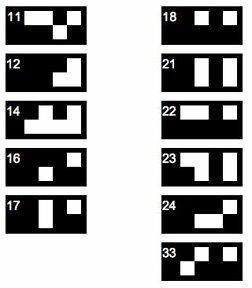
Iakov's comment to yesterday's post is right; the card images I posted yesterday fit a binary code. The card #9 we created worked fine in the scintillation counter.
But the simple binary code seems to fall apart for numbers higher than 10. Admittedly, we haven't worked very hard at solving it.
















A non-lab related comment to the non-lab related post. I periodically read your blog, more so because I'm fascinated that your posts contain information that would normally be considered private to most labs (though I do enjoy following along; you are very good and thorough at explaining your ideas). What made you dedide to post your daily scientific thoughts in the public? Are you worried that someone will not necessarily steal your ideas and thoughts, but rather steal your project(s) [i.e. worried a competitor is looking over your shoulder] ? I keep notes on my personal laptop with a nifty little program called Journler (for Mac), but I never hit the submit to the world button :) I take it you keep a written notebook in addition to your blog? Or is it all digital? Thanks in advance for replying ...
ReplyDeleteWe're lucky (sort-of) in not having any serious competitors. I say sort-of because the reason is partly that most microbiologists think we're wrong. They think it's self-evident (i.e. not worth questioning) that bacteria take up DNA for its genetic information, not for the nutrients it contains. I think they're wrong.
ReplyDeleteI think I should soon write a proper post (or series of posts) about this.
I keep a lab notebook on paper, with all the details of my experiments (e.g. added 0.05ml of cell s to plate #26 and 0.1ml of cells to plate #27) and the results, but I don't have a journal where I record the kinds of summaries and overviews I'm putting in the blog.
It was quite a challenge. After 30 minutes of unsuccessful looking at the cards, I tried to use statistical approach. I entered black and white squares as 8 continuos predictors in multiple linear regression with card number as a dependent variable. After some twiddling with numbers I included 2-way interaction terms in the model, and that was it - 100% of variance in card numbers were explained by the model. So the code is not random as it might seem, but more complex than just binary code. Unfortunately, regression coefficients are diffucult to express as simple rules to post here, but I can provide you with the regression equation in case you're interested.
ReplyDeleteIakov Vokhmintsev.
I'm sure the people who designed the cards weren't that clever. Maybe they were so dumb they couldn't extend their binary coding beyond 10, and so just used whatever patterns were convenient.
ReplyDelete